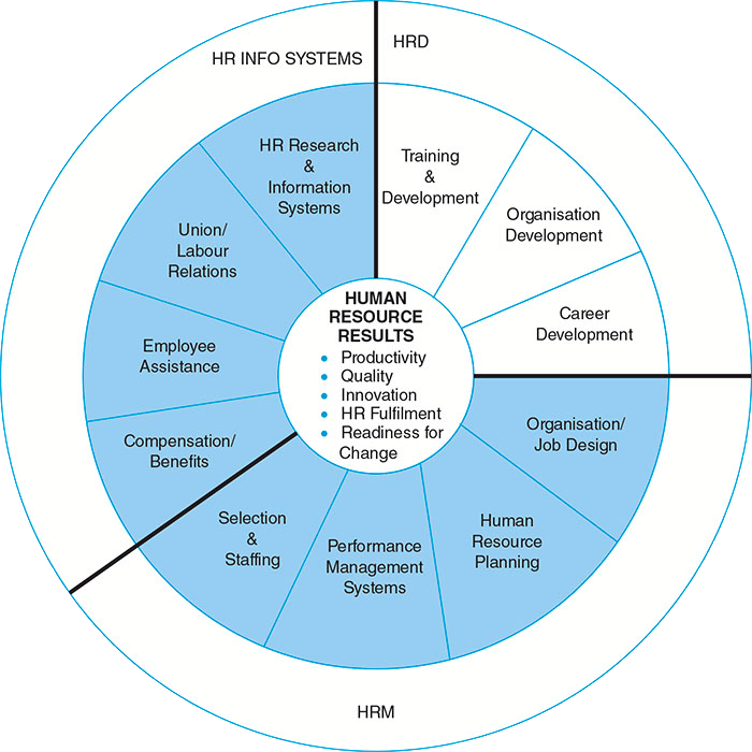What is Human Resource Development (HRD)? 2025 Complete Guide

Successful leaders make a point of developing their assets. And it goes without saying that your employees are your strongest assets.
Herein comes the role of human resource development (HRD), which is the framework set by an organization with different means of developing its employees.
So, how does human resource development work? This article provides a complete guide to the main function, tools, and benefits of human resource development. It also offers tips for efficient human resource development.

What is human resource development?
Human resource development (HRD) refers to the organization’s plan to help employees develop their abilities, skills, and knowledge. In return, this process enhances the organization’s efficiency.
Generally speaking, human resource development ensures the effectiveness and advancement of individual employees, collective departments, and the organization itself.
HR professionals focus on three primary aspects of human resource development in the HR life cycle:
- Training and development - improving knowledge and skills necessary for a future role or responsibilities
- Organization development - improving organizational effectiveness and well-being through macro and micro changes
- Career development - improving individual career planning and management through mentorship
Human resource development guarantees that your employee is competent enough to perform his/her current job. Moreover, it packs your employees with the necessary knowledge and strengths needed for career growth.
Recent changes in the concept of human resource development
In the past, the entire focus of any human resource department was to pick and maintain the right person for the job. Development programs and policies were one-size-fits-all approaches to keeping the workforce’s hard skills up to speed. However, this has changed recently.
Now the aim is to match the individual needs with those of the organization and provide internal support so both can accomplish their goals. This entails creating a growth culture with programs and policies that promote up-skilling and development.
HR must also help build a more agile and resilient workforce to adapt to the changing work environments. This new approach represents the company’s effort to contribute to the development of the individual and the organization.
What are the 7 elements of human resource development?

In an HR department, there are seven key human resource development functions:
1. Manpower planning, recruitment, and retention
Strategic staffing is the foundation for building a qualified workforce. Manpower planning, recruitment, and retention are top among human resource management concerns and critical to long-term business success.
While HR departments should aim to recruit and retain the best possible candidates, it’s important to remember they may not be the candidate with the most experience.
Employee development will help close any skills gaps, so when you’re forecasting and planning your human resource needs, don’t rely on finding the right person or tapping into the right talent supply. Plan for development that can help you attract and retain them as well, especially in these competitive labor markets.
2. Succession planning and talent management
Development programs can also help future-proof your organization’s productivity through succession planningOpens in a new tab. This talent management strategy involves identifying critical roles across an organization and developing a talent mobility program to train employees to step into these positions in the future.
Organizations will always experience turnover. Formal succession training and informal career coaching are effective contingency planning strategies to ensure your workforce will always have someone on hand with the knowledge and skills to perform critical tasks.
These strategies for talent management have the added benefit of engaging employees with their own growth and can help foster relationships between employees.
3. Policy and procedures
HRD requires identifying the needs of your business and developing suitable policies and procedures to meet them. This is achievable through a cycle of creating, launching, monitoring and improving initiatives for development.
HR departments must engage in collecting feedback and reporting on these policies and procedures to be certain their initiatives meet the needs of employees as well as organizations and their own departmental goals.
As part of the information gathering and planning stages, be sure to define these goals and measurements so you can launch your initiatives successfully.
4. Performance management system
A performance management systemOpens in a new tab aims primarily to ensure your workforce's alignment with your company’s strategic goals. Such systems combine methodologies and technologies that measure and develop employees' performance.
They are effective tools for continuously monitoring and improving development plans, as well as other aspects of performance management. HR professionals need to understand their system’s capabilities and define procedures for using them for development.
5. Compensation and benefits program
Compensation and benefits refer to two distinct concepts. Compensation refers to the cash return employees receive in the form of salaries or wages. Benefits, or fringe benefitsOpens in a new tab, are the various forms of non-cash rewards.
HR teams can use both to provide professional development opportunities through funding for classes, procurement of learning platforms, or the creation of internal training.
On top of their wages, your employees want peer recognition, autonomy, and other perks. Development opportunities are among one of the top perks applicants are seeking.
Therefore, following a solid human resource development plan can lure great talents who seek ongoing learning opportunities. This way, you can attract, maintain, motivate, and support your employees.
6. Employer brand communication and employee engagement
Employer branding is the process of creating a company profile or brand that attracts future employees. Human resource development enables you to let your employees do the branding for you.
Interestingly, you can’t create a powerful employer brand without investing in your current employees. We recommend that you establish a healthy culture of inclusion, trust, engagement, and diversity. This way, your employees can do the branding for you.
What are some examples of human resource development?
Human resource development can be done formally or informally. Here’s a list of formal and informal human resource development ideas:

Formal human resource development examples
- Tuition assistance
- Work-related college courses
- Personalized development plan
- Organizational training sessions
- Internal training with consultants or qualified staff members
Informal human resource development examples
- Mentoring by managers or more experienced employees
- Managerial coaching
- Cross-training with highly trained employees
4 priority topics for formal internal training
Internal training is one of the most important tools offered by organizations. Recently, some formal training topics have gained more significance, including:
1. Sexual harassment and discrimination prevention
There’s an ever-increasing body of legal imperatives related to sexual harassmentOpens in a new tab and discriminationOpens in a new tab in the workplace.
In turn, this has caused a sharp increase in the popularity of training for the prevention of such cases.
2. Risk management and safety
The Occupational Safety and Health AdministrationOpens in a new tab (OSHA) requires every organization to provide its employees, even temporary ones, with safety orientation training.
This ensures the rights and safety of every employee.
3. Supervisor training
Supervisor training provides important development opportunities for both senior and new staff.
It allows your qualified employees to polish their knowledge while delivering the training to the new ones.
4. Equal employment opportunity and diversity training
A solid program to motivate diversity and ensure equal opportunities in the workplace can help your business reach its strategic goals.
In fact, the US Equal Employment Opportunity Committee (EEOC) offers strong training courses in this field that you can benefit from.

5 benefits of human resource development
Human resource development is a major contributor to the well-being of any organization. It can be key to a stronger workforce, better relations, higher productivity, and profitability.
1. Attracting only the best
A company’s human resource development plan can be a major attraction to the best employees in the market. Generally speaking, career-oriented employees are always in search of new opportunities to develop and sharpen their skills.
In fact, a 2019 report found 86% of U.S. employeesOpens in a new tab said they would leave a position for an organization with development opportunities. And that was before the pandemic changed professional developmentOpens in a new tab approaches and the Great Resignation made learning and development a priorityOpens in a new tab for many organizations.
2. Increasing loyalty and satisfaction
The goal isn’t only to attract but also to retain talents. Job markets are incredibly dynamic. Therefore, you need to keep an edge to keep your ideal employees. This can be done by investing in them through human resource development opportunities.
Encouraging and improving your employees can be crucial to increase their loyalty and job satisfactionOpens in a new tab. As such, they’re more likely to remain with you.
SHRM found 86% of employeesOpens in a new tab believed career development was important to their overall job satisfaction.
3. Prepare for the future
Human resource development helps prepare employees for future posts. It allows them to develop new attitudes, skills, and knowledge to take on leadership positions.
On top of that, it helps you identify your employees’ strengths and weaknesses to create effective company succession planning strategies.
4. Raising the bar
Constant training and development can boost the performance level for the entire organization. In other words, a well-trained workforce excels and thus raises the business itself.
That’s mainly because human resource development fosters commitment and alters their attitude towards change with their new enhanced capabilities.
5. Fostering healthy relations
Investing in your human resources can be a great way to foster healthy relationshipsOpens in a new tab in the workplace. In short, creating an encouraging and ongoing learning environment increases a sense of respect and trust between you and your employees.
Moreover, such development plans promote the employees’ participation. This, in turn, enhances team spirit, allowing for a healthier workplace.
5 tips for effective HRD

Here’s a comprehensive guide for effectively applying human resource development for the utmost results.
1. Consistent check-ins
To foster an ongoing learning environment, we recommend that you arrange consistent sessions with a facilitator or a consultant for internal training, coaching, or simple check-ins on progress and goals.
For informal development, weekly meetings can easily be coordinated between the mentor and employee. When planning a formal or internal training cadence, aim for weekly meetings over a set number of weeks with milestones employees can plan around.
Note that internal training entails a presenter who’s familiar with your workplace spirit, language, and culture.
2. Baby steps
We recommend that you give your employees a reasonable amount of information to process. Don’t overwhelm them with new ideas and skills or you’ll increase their overall workload, risking burnout and limited retention or engagement with the training.
Pace your program and provide employees with different approaches to learning to accommodate schedules, learning styles, and their individual development goals.
Besides, when you provide employees with a manageable amount of data, they can easily implement them, showing you immediate development.
3. Constant feedback
Feedback is a two-way process, meaning, it should be constantly given and received.
Mentors and supervisors need to give employees consistent feedback to help them implement their newly acquired knowledge. They should similarly ask for feedback from employees.
HR teams should also request employee feedback on their programs and procedures. Their honest reflection can help you enhance your human development programs. Consider sending out pulse surveys to regularly collect feedback organization-wide about existing policies and desired development opportunities.
4. People are different
When performing a development plan, you should bear in mind that people learn differently. For instance, some employees may be able to grasp concepts through spoken information or visual aids. However, others need a more hands-on approach to fully understand ideas.
We said it before, but it’s worth repeating. You need to accommodate the different learning styles, which may involve helping employees design their own path for development.
5. Show appreciation
Your employees need to feel appreciated. Thus, we recommend that you use simple gestures of recognition and appreciation such as certificates, badges, or even verbal reaffirmation.
This way, you both encourage progressing employees and entice the rest to work harder. Doing so creates a strong workforce of life-long learners.
When planning learning initiatives, be sure to think about how to incorporate acknowledgment into your plan and communicate that need with key leaders.
Looking for an employee recognition program that not only moves the needle on your HRD metrics but also lifts employees to their full potential?
Check out Social Recognition® today.
FAQ
What’s the difference between HRD and HRM?
There are differences between the two concepts include:
- HRM focuses on administrative aspects while HRD focuses on learning and improving performance.
- The goal of HRM aims at improving employees, while HRD aims at the benefit of the entire organization.
- HRM is for the HR department, but HRD is for managers.
- HRM relies on financial motivation, but HRD motivates by appreciation and development.
What are the 4 types of training?
The four types of training are:
- Induction Training: the essential introduction given by the supervisor to ease the transition of new employees.
- Job Training: typically given by a senior employee about the specifics of a certain job.
- Training for Promotion: targets existing employees to prepare them for higher roles.
- Refresher Training: short seminars to help employees update their knowledge in their fields.
Conclusion
A healthy organization recognizes the importance of human resource development. Although HRD plans aim at the enhancement of individual employees, they affect the overall development of the organization.
For efficient human resource development, you should consider seven main elements. These include job evaluation, compensations and benefits, succession planning, and employer branding.
In today’s competitive job market, you should incorporate HRD to hire and retain the best employees that’ll help raise your company’s overall performance.